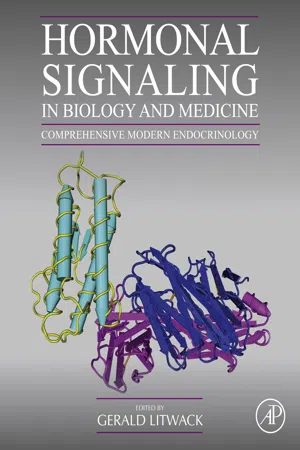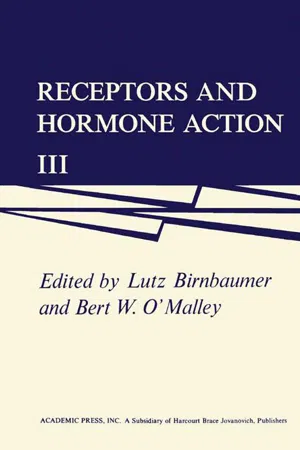Biological Sciences
Pineal Gland
The pineal gland is a small, pinecone-shaped gland in the brain that produces the hormone melatonin, which helps regulate sleep-wake cycles and circadian rhythms. It is also involved in the body's response to light and darkness. The pineal gland is considered a part of the endocrine system and is often referred to as the "third eye" due to its association with light sensitivity.
Written by Perlego with AI-assistance
Related key terms
11 Key excerpts on "Pineal Gland"
- eBook - ePub
- Anthony W. Norman, Helen L. Henry(Authors)
- 2014(Publication Date)
- Academic Press(Publisher)
Chapter 16The Pineal Gland
The Pineal Gland was identified as a distinct structural component of the vertebrate brain for several centuries prior to its description in the human by Galen of Pergamon (c. 130–200). It is now understood that the main function of the pineal is to receive information about the current state of the light–dark cycle from the environment and convey this information through the secretion of the hormone melatonin to the internal physiological systems of the body. Relative to other endocrine and neuroendocrine systems, the Pineal Gland has undergone a great deal of change during its evolutionary development. In cold-blooded vertebrates, the cells of the Pineal Gland include photoreceptors that contact neurons to communicate with other organs in the body. The avian Pineal Gland is also a directly photosensory organ and secretes melatonin in response to this signal. In mammals, pinealocytes producing melatonin have replaced photoreceptors and the gland receives its information about light and darkness from the retina through multiple neuronal connections. Melatonin is secreted during the dark period of the day and, through its elevated blood levels, informs, through specific cell receptors, the peripheral organs and tissues regarding the light/dark cycle. In addition to its function of sending information to the periphery regarding light and dark, melatonin from the Pineal Gland also contributes to the entrainment of the central SCN oscillator to the light–dark cycle. This chapter covers the anatomical features of the Pineal Gland, the synthesis and secretion of melatonin, the biological actions of melatonin, and various clinical aspects related to the Pineal Gland. - eBook - ePub
Melatonin
Biosynthesis, Physiological Effects, and Clinical Applications
- Hing-Sing Yu, Russel J. Reiter(Authors)
- 2020(Publication Date)
- CRC Press(Publisher)
1 From myth evolved fantasy and early observations linking the pineal and sexual competence was postulated. With the introduction of experimental biology, pineal activities and their close association with circadian oscillations in body functions have rejuvenated inquires into the regulation and periodic expression of genes within the pineal.Circadian rhythms and neuroendocrine physiology can hardly be discussed without introduction of the pineal and its major hormone, melatonin.2 ,3Much is known about the morphology, biochemistry, and physiology of the pineal and its position in the pineal/retina/hypothalamus trilogy that controls and modulates circadian rhythms and neuroendocrine function.4 Nonetheless, only a limited number of studies have dealt with the genetic regulation of neuroendocrine activities within the Pineal Gland.5The small size of the pineal, relative to the retina and brain, have placed investigations of the pineal at a considerable technical disadvantage. Recent advances in molecular biology techniques, however, have greatly overcome this handicap and made investigations of gene expression in the pineal more assessable. With the tools of molecular biology, systematic study is now possible to characterize mRNAs that are specifically localized to the pineal, as well as those shared selectively with the retina and/or hypothalamus. Understanding the mechanisms of gene expression will reveal the means by which the circadian oscillations are prompted within the pineal and they will help provide the key to understand conceptually the regulation of neuroendocrine function within the pineal. - eBook - ePub
Maternal-Fetal and Neonatal Endocrinology
Physiology, Pathophysiology, and Clinical Management
- Christopher S. Kovacs, Cheri Deal, Cheri L. Deal(Authors)
- 2019(Publication Date)
- Academic Press(Publisher)
13 is a hormone carrying a photoperiodic signal triggered by the endogenous clock, the suprachiasmatic nucleus (SCN). Melatonin is intimately involved in physiology, modulating circadian rhythms and regulating sleep/wake cycles and seasonal rhythmicity in mammalian species. It plays important roles in regulating and timing neuroendocrine, reproductive, cardiovascular, immune and nervous system functions. Moreover, melatonin is a free-radical scavenger with potent antioxidant activity, intervening to balance the oxidative challenge that accompanies physiological and pathological circumstances.Much of the data regarding the Pineal Gland have arisen from animal studies, and so some caution is warranted in correlating these data with normal human physiology. Also, melatonin has been shown to be produced in small amounts in extrapineal sites such as the skin, gastrointestinal tract, retina, bone marrow cells, placenta, and ovaries14 – 18 and also in virtually every nucleated cell from various tissues and organs, wherein it functions in paracrine or autocrine ways to influence homeostatic balance.19Considering that melatonin is involved in the regulation of whole-body physiology and affects reproductive function, appetite, body weight, and behavior, the function of the Pineal Gland during gestation and lactation should be of high interest and relevant to both maternal and fetal physiology. This is supported by an association between low plasma levels of melatonin and the incidence of preeclampsia and fetal growth restriction, as well as by evidence of an increased success rate of in vitro fertilization when melatonin has also been used.202.2 Anatomy of the Pineal Gland
The Pineal Gland is an unpaired neuroendocrine organ located in the midline of the brain, in a groove flanked by the thalamic bodies. It is connected to the roof of the third ventricle by a small pineal stalk consisting of two lamina, rostral and caudal. In humans, the pineal is part of the epithalamus, a component of the diencephalon, together with the medial and the lateral habenulas (Figs. 2.1 and 2.2 ). The pineal is covered by a pial capsule and hangs in the cerebrospinal fluid (CSF) of the pineal recess, having direct contact with the third ventricle. Superiorly, it relates to the internal cerebral veins and the great cerebral vein of Galen, being located right above the superior colliculi of the midbrain.7 In rodents, the Pineal Gland is located superficially, between the cerebral cortex and the cerebellum, connected by the pineal stalk to its more profound component situated in the epithalamic region. The Pineal Gland in the human adult weighs between 0.1 and 0.2 g and measures about 5–12 mm × 2–4 mm × 3–5 mm in size, sometimes displaying a round-shaped or pine-cone appearance, which gave the name pineal - eBook - ePub
- G. M. Besser, Luciano Martini, G. M. Besser, Luciano Martini(Authors)
- 2013(Publication Date)
- Academic Press(Publisher)
This chapter describes the effects of melatonin and other pineal agents in humans. The Pineal Gland is an actively secreting endocrine gland that affects diverse aspects of brain and endocrine physiology. A common feature of these glands is that they are usually solid and well-vascularized parenchymatous organs containing characteristic cells termed pinealocytes that have a secretory function. The mammalian Pineal Gland differs from the saccular pineals of submammalian species that consist of photoreceptor and sensory nerve cells. The pineal contains all the enzymes necessary for catecholamine synthesis and noradrenaline. Studies suggest that in schizophrenia pineal, HIOMT may be out of phase with its normal substrate and may thus act on abnormal substrates to produce the dimethylated metabolites responsible for the disease. Depression, as suggested by many researchers, may result from a deficiency of serotonin or catecholamines or both. Melatonin secretion has been examined in manic and depressive patients because of evidence linking these disorders with derangements in biological rhythms and with an altered noradrenergic activity. Many investigations in the pineal’s role in human and mammalian physiology need to provide a better understanding of the same; principal among these are the effects of the gland in brain and endocrine function and the mechanisms involved. The role of the pineal in human circadian periodicity, sleep, and behavior also await elucidation.I. IntroductionA. Pineal Morphology B. Pineal Biochemistry C. Pineal Physiology D. Pineal Pharmacology E. Regulation of Melatonin in the HumanII. Pineal-Brain InteractionA. Central Nervous System Effects B. Psychiatric Implications C. Endocrine Effects D. Endocrine Rhythm Regulation E. Possible Mechanisms of Melatonin ActionIII. Human PathologyA. Pineal B. Other PathologyIV. Future Trends in Pineal Research ReferencesI. INTRODUCTION
After being regarded for decades as a vestigial organ of no importance in the economy of the body, the Pineal Gland has in recent years been acknowledged to be an actively secreting endocrine gland which affects diverse aspects of brain and endocrine physiology. The pineal’s current respectable status has come about largely as a result of the upsurge in pineal research which followed the discovery of the putative pineal hormone, melatonin, about 20 years ago by Lerner and co-workers (1958 , 1959 ). Quite understandably, numerous studies were directed at determining the role of melatonin in mammalian physiology and these led to the formulation of the “melatonin hypothesis of pineal function” as described by Wurtman and Axelrod (1965) .Today, while a great deal is known about pineal anatomy, biochemistry, and pharmacology, the gland’s true niche in mammalian and particularly human physiology remains to be clarified. Nonetheless, the pineal’s influence on brain, endocrine, and particularly reproductive function is well documented. In addition, the pineal’s ability to transduce neurally coded photic information into chemical or hormonal output has implicated the gland in the regulation of biorhythmicity which is often cued to environmental lighting. While this chapter is primarily concerned with the effects of melatonin and other pineal agents in humans, the relative scarcity of studies in this area necessitates considerable reliance on data derived from mammalian studies. - eBook - ePub
Hormonal Signaling in Biology and Medicine
Comprehensive Modern Endocrinology
- Gerald Litwack(Author)
- 2019(Publication Date)
- Academic Press(Publisher)
Chapter 6The Pineal as a Gland and Melatonin as a Hormone
Richard J. Wurtman Massachusetts Institute of Technology, Cambridge, MA, United StatesAbstract
The human pineal is an unpaired midline organ, derived from and surrounded by brain tissue, which secretes a hormone, melatonin, into the blood and the cerebrospinal fluid, principally during the daily dark period. The melatonin then activates receptors on brain neurons to provide a time-signal for various circadian rhythms, to promote sleep onset, and principally, sleep maintenance during the night. The deficiency in nocturnal plasma melatonin levels that often occurs among older people, caused by the unexplained tendency of their pineals to develop progressive calcification, is a frequent cause of decreased sleep efficiency, manifest as the tendency to awaken for prolonged periods during the night. This can be treated by “hormone replacement therapy” using small doses of oral melatonin, just sufficient to raise its blood levels to what they were nocturnally earlier in life.Melatonin's synthesis starts with the 5-hydroxylation of the essential amino acid tryptophan, followed by its decarboxylation to form serotonin (5-hydroxytryptamine). In the pineal, but to a very limited extent elsewhere in the body, this serotonin is converted to melatonin by enzymes that acetylate its amine nitrogen, forming N-acetylserotonin, which is then O-methylated to form the melatonin (5-methoxy-N-acetyltryptamine). When humans and other mammals are in darkness the electrical activity of, and norepinephrine release from, the pineal's sympathetic nerves are maximal, and the intrasynaptic norepinephrine acts on pineal beta receptors, forming cyclic-AMP and activating the enzymes that will convert the serotonin to melatonin. Conversely, exposure to environmental lighting diminishes the pineal's sympathetic activity and its synthesis of melatonin. In submammalian vertebrates the pineal organ often contains photoreceptors, through which light exposure can directly affect brain. - eBook - ePub
- Paul V. Malven(Author)
- 2019(Publication Date)
- CRC Press(Publisher)
Chapter 10Pineal Gland
The Pineal Gland is a small diverticulum of ependymal cells dorsal to the third ventricle and adjacent to the epithalamus. The name derives from the Latin term pinea (pine cone), the shape of which it resembles. Because the Pineal Gland is not bilaterally represented as are most CNS structures, ancient scholars attributed important functions to it. The terms pineal gland and pineal organ are both used, and each name is correct. Pineal Gland, the name used in this book, is an appropriate term because the cells secrete a hormone (melatonin) into the blood. Pineal organ is also an appropriate name because the structure is one of several circumventricular organs (see Chapter 4 ). The cells of the Pineal Gland are called pinealocytes, and they function as neuroendocrine transducers as described in Chapter 1 (Figure 1-1 ). This transduction consists of converting action potentials (AP) of postganglionic sympathetic neurons into melatonin secretion by the pinealocytes.Changes in the Pineal Gland during evolution leading up to mammals reflect a progressive loss of photoreception by the pineal structure. In amphibians and lower species, the Pineal Gland appears to function as a third eye, having photoreception and electrical activities consistent with visual function. Although visual functions were lost during evolutionary development, the Pineal Gland of birds and mammals retains the capacity to be influenced by ambient light. The Pineal Gland of birds appears, at least in part, to be directly sensitive to ambient light passing through the cranium. In mammals, the pinealocytes are modulated by ambient light, but this effect is mediated by retinal photoreception occurring in the eye.The gross morphology of the Pineal Gland ranges from a spherical shape in ruminant ungulates to a cylindrical structure containing deep and superficial portions in rodent species (Rollag et al., 1985). The pineal tissue consists of non-neuronal parenchymal cells, the pinealocytes, that share some antigenic characteristics with retinal cells but not neuroglia (Korf et al., 1986). The Pineal Gland contains a few neuroglial cells but lacks neuronal perikarya. Although there is a tissue connection between the Pineal Gland and adjacent epithalamus, there do not appear to be any axons passing through this connecting neural tissue. However, there are numerous axonal terminals in the Pineal Gland; they are derived from postganglionic axons that originate outside the CNS in the superior cervical ganglion (SCG). The SCG is the rostral-most ganglion of the sympathetic chain, and it contains the perikarya of postganglionic sympathetic neurons. The perikarya in the SCG are activated by preganglionic axons originating in the CNS. Postganglionic axons enter the Pineal Gland from outside the CNS and innervate pinealocytes. Norepinephrine (NE) is the neurotransmitter released at these secretomotor terminals (see Figure 1-1 - eBook - ePub
Advances in Metabolic Disorders
Volume 6
- Rachmiel Levine, Rolf Luft(Authors)
- 2013(Publication Date)
- Academic Press(Publisher)
The Pineal Gland—A Neuroendocrine Transducer
R. Collu* and F. Fraschini† ,* Department of Pediatrics, University of Montreal and L’Hôpital Sainte-Justine, Montreal, Canada;† Department of Pharmacology, University of Milan, Milan, ItalyPublisher Summary
This chapter discusses the Pineal Gland, which is a neuroendocrine transducer. The mammalian Pineal Gland arises embryologically as an outgrowth of the roof of the third ventricle, but soon after birth, it loses all neural connections with the brain to which it is attached only by a thin stalk. The main reason for considering Pineal Gland as the Cinderella of endocrinology is that no major, or long-lasting, harm follows its removal. Like a safety valve, the Pineal Gland prevents the occurrence of unphysiological events, such as precocious puberty, like a biological clock regulated by light, it sets the timing of periodic events such as ovulation. The Pineal Gland also exerts a generalized inhibitory influence over a group of bodily functions. Therefore, it is possible that the real physiological role of the gland is simply that of a brake that helps to maintain the homeostatic equilibrium of the organism.I IntroductionII Effects on the Reproductive SystemIII Effects on the Adrenal GlandsIV Effects on the Thyroid GlandV Effects on Growth and Growth HormoneVI Nonendocrine EffectsVII ConclusionsReferencesI Introduction
Few organs have raised more controversial debate than the Pineal Gland, or shown more clearly the capricious nature of scientific knowledge. It was described by Descartes as the seat of the soul in his book “De Homine”; but in the twentieth century it was considered either a useless vestigial structure or a multifunctional endocrine gland. In the last 20 years, histochemical, biochemical, and electron microscopic methods have enabled researchers to better evaluate the function of the Pineal Gland of different animal species (Mess, 1968 ;Wurtman et al., 1968; Reiter and Fraschini, 1969) - George H. Gass, Harold M. Kaplan(Authors)
- 2020(Publication Date)
- CRC Press(Publisher)
Chapter 3THE Pineal Gland AND MELATONIN
Jerry Vriend and Nancy A.M. Alexiuk
CONTENTS Introduction Anatomy Phylogenetic Considerations The Mammalian Pineal Gland Anatomy Ultrastructure of Mammalian Pinealocytes Blood Supply Innervation Biochemistry Purification and Identification of Melatonin Peptides in the Pineal Gland Sythesis and Regulation of Melatonin Secretion Distribution and Metabolism of Melatonin Assays for Melatonin Physiological Effects of the Pineal and Melatonin in Control of Endocrine Systems Effects on the Hormones of Reproduction in Males Effects on the Hormones of Reproduction in Females The Pineal and Thyroid Hormones Pineal-Thyroid and Pineal-Gonadal Axes: Are They Independent? Effects on the Adrenal Gland Effects on Growth Hormone Secretion Other Effects of the Pineal Gland The Pineal Gland and the Central Nervous System Melatonin Binding Sites Melatonin and Second Messenger Systems Melatonin and Neurotransmitters Pineal Research and Circadian Rhythms Melatonin: Psychopharmacological Effects and Clinical Implications Pineal Gland and Seizures Pineal and Melatonin: Oncology and Immunology Melatonin and Immune Response Pineal Tumors ReferencesINTRODUCTION
The inclusion of a chapter on the Pineal Gland suggests that the Pineal Gland has a kinship with the other classical endocrine glands. Like other glands that deposit hormones into the blood vascular system, the Pineal Gland is a highly vascular structure. It is now well documented that the Pineal Gland secretes at least one active substance, N-acetyl-5-methoxy-tryptamine, commonly known as melatonin. This indole has been detected both in the Pineal Gland, from which it was originally isolated,1 , 2 and in the circulation of amphibians,3 birds,4 fish,5 , 6 and a large number of mammalian species including man.7 , 8 , 9 , 10 , 11 , 12 , 13 , 14 , 15 , 16- eBook - ePub
- V. H. T. James, L Martini(Authors)
- 2013(Publication Date)
- Academic Press(Publisher)
Melatonin and the Endocrine Role of the Pineal Organ
Daniel P. Cardinali* , I.L.A.F.I.R., Universidad del Salvador, San Miguel, P.B.A., ArgentinaPublisher Summary
The indoleamine serotonin is found in several tissues in the body; its 5-methoxy derivatives are primarily produced by and have been isolated from the pineal. Melatonin (5-methoxy-N-acetyltryptamine) is the prototype of this family of biologically active compounds; its characterization constituted a landmark in the study of pineal physiology inasmuch as it was the first substance to be characterized in the pineal that reproduced many of the effects of pineal extracts or reversed the endocrine sequelae that occurred following pinealectomy. Most attempts to induce melanocytic response to melatonin have failed in mammals; this is partially due to the inability of mammalian melanophores to cause lightening by intracellular aggregation of the dermal pigment. In place of dermatological actions, melatonin has come to exert effects on another neuroectodermal derivative, the brain. The pineal participates, through the secretion of melatonin, in the control of certain neuroendocrine and neurophysiological rhythms; it also mediates some of the effects of light on gonadal maturation, the ovulatory cycle, and the secretion of pituitary hormones.I IntroductionII Melatonin BiosynthesisA Neural Control of Melatonin Synthesis. Pineal Responses to LightB Hormonal Control of Melatonin SynthesisIII Melatonin MetabolismIV Melatonin and Pinealectomy-Induced Endocrine ChangesV Other Possible Sources of MelatoninVI ConclusionsReferencesI Introduction
Although the indoleamine serotonin is found in several tissues in the body, its 5-methoxy derivatives are primarily produced by and have been isolated from the pineal. Melatonin (5-methoxy-N - eBook - ePub
Receptors and Hormone Action
Volume III
- Lutz Birnbaumer, Bert O'Malley, Lutz Birnbaumer, Bert O'Malley(Authors)
- 2013(Publication Date)
- Academic Press(Publisher)
7Regulation of β-Adrenergic Function in the Rat Pineal Gland
MARTIN ZATZ, JOHN W. KEBABIAN and ROBERT F. O’DEAThe modern era in pineal research began with the isolation and identification of melatonin from bovine pineals by Lerner et al. (1958) . Evidence indicates that the Pineal Gland is an endocrine organ that synthesizes and secretes melatonin (Wurtman et al., 1968 ). This hormone has many potent physiological effects. In mammals, it modulates the activities of several endocrine organs, particularly the gonads (Wurtman et al., 1963a ) and the pituitary (Kamberi et al., 1970 ; Fraschini et al., 1971 ). The Pineal Gland, and possibly melatonin, may be involved in the effects of light on reproductive cycles and maturation (Hoffman and Reiter, 1965 ; Wurtman et al., 1964 ). The physiology of melatonin has been reviewed elsewhere (Reiter, 1973 ; Wurtman, 1974 ).I. β-Adrenergic Stimulation of Melatonin SynthesisA. Synthesis of MelatoninB. Effects of Light and Circadian RhythmsC. β-Adrenergic Stimulation of N -AcetyltransferaseD. Multiple Sites of Action of Cyclic AMPII. Regulation of Sensitivity to β-Adrenergic StimulationA. Induction of N -AcetyltransferaseB. Accumulation of Cyclic AMPC. Activation of Cyclic AMP-Dependent Protein KinaseD. Cyclic GMPIII. ConclusionReferencesI β-ADRENERGIC STIMULATION OF MELATONIN SYNTHESIS
A Synthesis of Melatonin
In the two decades since its discovery, a great deal has been learned about the mechanisms regulating the synthesis of melatonin (Axelrod, 1974 ). The key intermediate in the synthesis is serotonin (5-hydroxytryptamine) (Giarman and Day, 1959 ). This compound is formed from tryptophan by the successive actions of tryptophan hydroxylase (Lovenberg et al., 1967 ) and 1-aromatic amino-acid decarboxylase (Snyder and Axelrod, 1964 ). In the pineal, serotonin can be N -acetylated by serotonin N -acetyltransferase using acetyl-CoA (Weissbach et al., 1960 ). The N -acetylserotonin that is formed is then O -methylated by hydroxyindole-O -methyltransferase (Axelrod and Weissbach, 1961 ) to form 5-methoxy-N -acetyltryptamine, which is melatonin (Fig. 1 ). As will be discussed further, the action and synthesis of the enzyme N -acetyltransferase appears to be the pivotal step in the regulation of melatonin synthesis, and N - eBook - ePub
Neuroendocrine Perspectives
Volume 3
- Eugenio E. Müller, Robert M. MacLeod, Eugenio E. Müller, Robert M. MacLeod(Authors)
- 2013(Publication Date)
- Elsevier(Publisher)
By definition, an endocrine gland qualifies as such only if it releases a hormone into a bodily fluid. There is a single report stating that 3 months after pinealectomy there are elevated levels, albeit no rhythm, of plasma melatonin in the sheep (Kennaway et al., 1977). Assuming it was melatonin being measured, this study emphasizes the possible contributions of other melatonin producing organs, e.g., the retinas or Harderian glands, to the level of this constituent in the blood (Brown et al., 1981a). Melatonin has been detected in the plasma of all mammals in which attempts have been made to measure it. Some of these species include the rat (Pang and Ralph, 1975 ; Ozaki et al., 1976 ; Wilkinson et al., 1977), Syrian hamster (Brown et al., 1981c ; Reiter et al., 1982c, d), sheep (Rollag and Niswender, 1976 ; Kennaway et al., 1977 ; Rollag et al., 1977), pig (Kennaway et al., 1977), cow (Kennaway et al., 1977), monkey (Reppert et al., 1979), camel (Kennaway et al., 1977), and human (Vaughan et al., 1976 ; Arendt and Wilkinson, 1978 ; Lynch et al., 1978 ; Waldhauser and Wurtman, 1983). In all of these studies the values measured at night were higher than daytime titers, usually by a factor ranging from 2 to 12. Besides its presence in blood, melatonin is also detectable in the CSF of mammals (Ozaki et al., 1976 ; Hedlund et al., 1977 ; Reppert and Klein, 1980). Typically, the levels of melatonin in this fluid exhibit a rhythm similar to that observed in the plasma. There has been considerable interest in the possible direct secretion of pineal melatonin into the third ventricle of the brain, particularly in those mammals in which the gland is in a subcallosal position and contains a prominent pineal recess (Reiter et al., 1975). Despite this possibility, the hypothesis that the release of melatonin occurs directly into the CSF has not gained widespread support (Rollag et al., 1977 ; Brown et al., 1981b)
Index pages curate the most relevant extracts from our library of academic textbooks. They’ve been created using an in-house natural language model (NLM), each adding context and meaning to key research topics.










